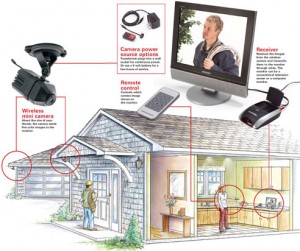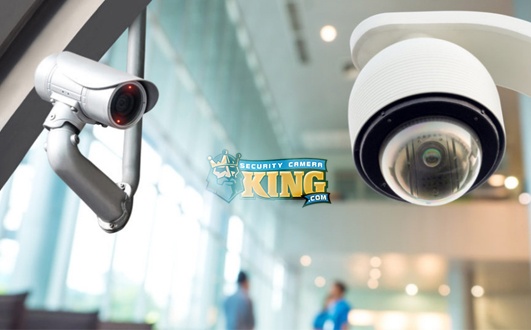 If you don’t want to run coaxial cable from each digital video security home camera to a Digital Video Recorder (DVR) or personal computer and you want a high quality color video image, quality wireless security home cameras may be for you. Security Camera King carries a large selection of quality wireless security home cameras and security camera systems.
If you don’t want to run coaxial cable from each digital video security home camera to a Digital Video Recorder (DVR) or personal computer and you want a high quality color video image, quality wireless security home cameras may be for you. Security Camera King carries a large selection of quality wireless security home cameras and security camera systems.
There are basically two types of quality wireless security home cameras. Each camera transmits its signal using some sort of radio signal technology, but they differ in that each type transmits to a different destination or receiver. One type transmits its digital video signal to a corresponding receiver and the other transmits its signal to a wireless internet modem or router to connect to the internet.
Let’s discuss each one of the quality wireless security home cameras, but before we do, let’s briefly describe a non-wireless security home camera system for comparison. A non-wireless system consists of three basic components: 1) A camera or cameras; 2) A DVR; and, 3) A monitor. Some systems utilized computer PCI cards that receive, process, compress, and store the video images using a personal computer. These devices can eliminate the need for a DVR and a monitor as the computer is used in their place.
A basic system operates by capturing the video with the digital video camera. The camera transfers the image into an electronic signal that is sent via a coaxial cable to the DVR or personal computer. The DVR or computer then assembles the data into a digital video file that can be viewed on a monitor and stored on the DVR or computer hard drive for later viewing or archiving purposes.
The first quality wireless security home camera method eliminates the video transmission cable by sending the digital video signal by radio waves to a corresponding wireless receiver. The receiver is then connected to a DVR or a server for internet access.
The transmitter and antenna are built into the camera. The transmitter usually uses the same 2.4 or 5.8 GHz radio band spectrum technology that wireless home telephones use. These cameras normally specify their ranges in terms of Line Of Sight or LOS. The maximum LOS range for a camera is the distance the camera can operate with a direct Line Of Sight between it and the receiver. In other words the range is stated based on no objects blocking or impeding the transmission path between the camera’s antenna and the receiver’s antenna.
However, if something does block the LOS, the camera doesn’t necessarily fail to work. Instead, depending on the material of the object, the range is usually just reduced. Normally, walls, windows, and buildings for example do not entirely block the wireless signal, they just reduce the useful range. Once the signal reaches the receiver, it transforms the signal from a radio signal back into an electronic signal and transmits it via a cable connection to the DVR or personal computer.
The second quality wireless security home camera method involves sending the video signal to wireless modem or router to be transmitted via the internet. This cameras usually take advantage of WiFi or 802.11 wireless technology to transmit their signals. The difference between this and the first method mentioned above is that the first method basically sends a raw video signal. The second method involves using cameras that have built in processors and servers so that instead of sending a raw video signal, they are actually sending a “packaged” digital computer file via radio waves to the internet.
These cameras are often referred to as Internet Protocol or IP ready cameras. Since they contain all the necessary circuitry to process, compress, and send the signal via the internet, they can be remotely accessed from anywhere in the world that broadband internet access is available. Although these cameras can be connected to a DVR via the internet, it is not always necessary as they can utilize a typical personal computer to do the job of monitoring, controlling, and storing the digital files.
So whether it is a locally based wireless system or an IP ready wireless system, quality wireless security cameras can easily satisfy your need for a peace of mind. Their wireless technology allows the cameras to be mounted in areas that might not otherwise be possible with cabling and installation is a cinch. In addition, quality wireless security home cameras are economically priced to fit just about any home budget.











